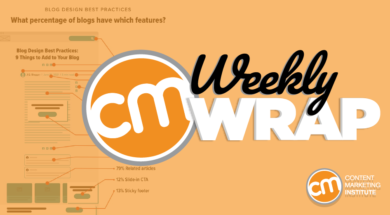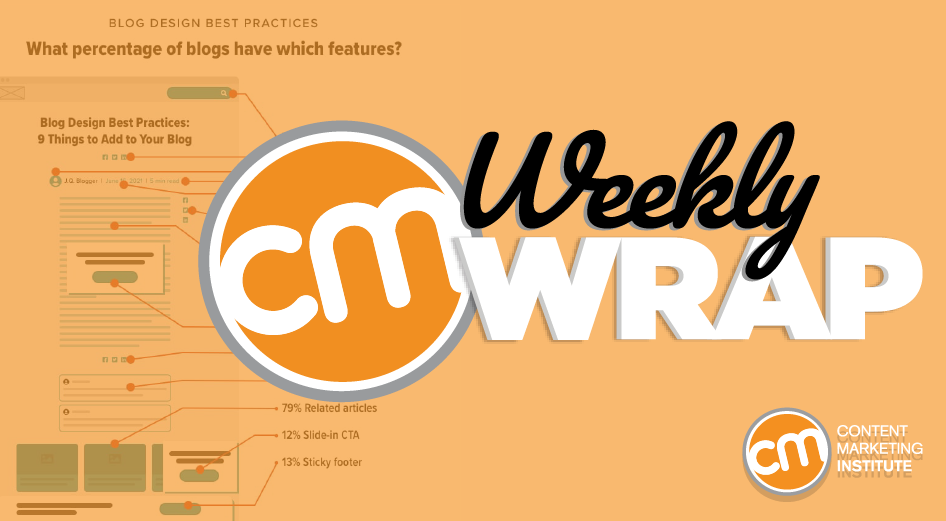 This week, we’re all about that data. Orbit Media studied the common characteristics of marketing blog designs. AT&T experts turned commonly searched spelling advice into engaging content. And the Purpose Power Index highlighted the changing understanding of purpose-driven businesses.
This week, we’re all about that data. Orbit Media studied the common characteristics of marketing blog designs. AT&T experts turned commonly searched spelling advice into engaging content. And the Purpose Power Index highlighted the changing understanding of purpose-driven businesses.
The devil in the design details
It doesn’t matter how wonderfully created and intriguing your content is if your audience can’t easily access, consume, or share it.
Obit Media recently conducted a mini-study of the user experience on marketing blogs, which revealed some interesting commonalities. The resulting blog post, How to Design a Blog: The 13 Best Practices of the Top 100+ Marketing Blogs, explores the percentage of blogs that use certain features, such as popups, author pictures, dates, comments, etc.
Here’s are interesting findings on sharing buttons:
- 36% of top marketing blogs put their sharing buttons at the top of the page
- 35% put them on the side
- 33% include them at the end of the article
As Orbit’s Andy Crestodina notes in the blog post discussing the study, “there’s no correlation between reading and sharing.” So, it makes sense to make social sharing buttons easily accessible as early as possible.
Andy’s advice: Put sharing buttons at the top and add them to the side and bottom – as long as it doesn’t clutter the design.
One takeaway that surprised him: The most common feature on these blogs was “related articles.” Orbit Media’s blog doesn’t offer that feature, but they’re reconsidering that decision now.
WHY IT MATTERS: Content creators and strategists invest significant time in identifying what topics and formats resonate best with our audiences. Unfortunately, fewer spend much time (if any) analyzing the user experience on content pages. While Orbit’s research identifies the most popular features, it’s a good reminder to investigate your UX, which matters almost as much as the headline.
.@crestodina studied the #UX of 100+ marketing #blogs – and found a popular feature was missing from his own site. Does your blog have it? @CMIContent #WeeklyWrap Click To Tweet
How do you spell … corn teen?
AT&T Experts reviewed a year’s worth of Google data to create an interactive map called Each State’s Most Commonly Misspelled Words.
To create the map, the AT&T Experts team reviewed data from “how to spell” questions searched on Google from March 24, 2020, to March 24, 2021.
The data revealed that searchers in 12 states looked for the correct spelling of one word more than any other. The most common misspelling used in the searches for this word was “corn teen.” Can you guess the word?* (Skip to the end of the article to find out if you guessed correctly.)
The word “favorite” came in second (as the most commonly searched misspelled word in seven states). “Coronavirus,” “which,” and “every” rounded out the top five.
WHY IT MATTERS: Let’s focus on the positive – these searchers were interested in learning the correct spelling of the words. But the project itself is a great example of content marketing. AT&T Experts transformed the Google data to tell a story that grabs an audience’s attention and makes them want to share it.
Corn teen, anyone? .@ATT Experts turned people’s searches for spelling help into can’t-look-away #content. via @CMIContent. #WeeklyWrap Click To TweetFinding purpose in upheaval
The Purpose Power Index measures how consumers think and feel about a brand’s mission in society (in other words, its higher-order reason to exist beyond making a profit). The data comes from a survey of more than 6,500 people who were asked about 200-plus brands.
Half of the top purpose-driven brands in the 2021 report are new to the index. And they’re bigger companies. Eight of the top 10 purpose brands in this year’s study had revenues of $10 billion or more, while the top 10 in the 2019 index included only one company of that size.
The 2019 index included more founder-driven, purpose-born brands. Though some of those brands like Seventh Generation and TOMS made the 2021 top 10, newcomers included big pharmaceutical companies such as Pfizer, AbbVie, and GlaxoSmithKline, bolder brands like SpaceX and Tesla, and hygiene brands such as while Clorox and mask-making 3M.
WHY IT MATTERS: The Purpose Power Index is a good barometer for the shift in the meaning of “brand purpose” that occurred during the pandemic. When people need your product or services, they’ll think more highly of your brand’s reason for existing beyond profit-making.
You don’t need a pandemic to test this. Even a brief surge in interest is a great time to strengthen connections with your audience.
Create a supplemental plan to your content marketing strategy now, so you can react quickly when new opportunities arise. What numbers need to inflate to lead to a shift in your content marketing strategy? Who’s on the team to evaluate the plan’s activation in real-time? What are your implementation options? Plan now so you’re prepared for the future.
Move over purpose-born brands. Big pharma muscled its way onto the Purpose Power Index, an impressive piece of #ContentMarketing from @Frogism & @RepTrak via @CMIContent. #WeeklyWrap Click To Tweet*Quarantine is the answer to the most-searched spelling question.
Cover image by Joseph Kalinowski/Content Marketing Institute

